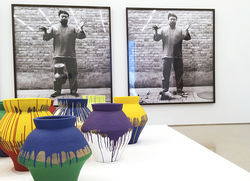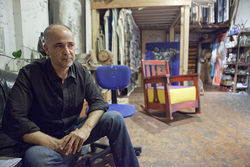Maximo Caminero's Million-Dollar Attack on the Miami Art World

On February 16, a middle-aged man with hazel eyes and a crown of salt-and-pepper hair walked into Pérez Art Museum Miami. The heavy wooden doors on the new $220 million public building swung open with a whisper. Smooth jazz murmured from speakers hidden somewhere in the Dorothy and Aaron Podhurst Lobby. In the gift shop, teenagers in thick-framed glasses peddled $15 PAMM coffee mugs, $14 Frida Kahlo candles handmade in Peru, and $175 "reversible" Swiss cross blankets. The man forked over $12 for a ticket.
He didn't look like a tourist. While sunscreen-slathered visitors slapped around the museum in sandals and shorts, he was dressed unseasonably in a red jacket, black pants, and a stocking cap. And as the tourists traipsed straight upstairs to see the star attraction — an exhibition by Chinese dissident artist Ai Weiwei — the man meandered around the first floor. He paused in front of a charcoal nude by Cuban artist Wifredo Lam, scratched his head at the sight of a three-foot scroll that Carolee Schneemann once pulled from her vagina, and lingered lovingly in front of a large painting by José Bedía, who happened to be his friend.
With each work of art, however, the man grew more frustrated. Of the 44 pieces on display downstairs, only two — including Bedía's — were by locals. Most of the artists hailed from Cuba or New York, and nearly all of them were dead.

Related Stories
 The Art of Wine at Boca Raton Museum of ArtDecember 12, 2013
The Art of Wine at Boca Raton Museum of ArtDecember 12, 2013 There's a Touch of Broward at Art BaselDecember 5, 2013
There's a Touch of Broward at Art BaselDecember 5, 2013 Art Basel Satellite Fairs in Miami Beach Transform the Tourist MeccaDecember 5, 2013
Art Basel Satellite Fairs in Miami Beach Transform the Tourist MeccaDecember 5, 2013 Breaking Basel: New Times' Guide to Art Basel 2013December 5, 2013
Breaking Basel: New Times' Guide to Art Basel 2013December 5, 2013 Miami Art Week's Newest FairsDecember 5, 2013
Miami Art Week's Newest FairsDecember 5, 2013
More About
The man headed upstairs and passed under a giant screen on which Ai Weiwei quotes were projected. One claimed Ai had been "born radical." Another argued, "I think we have too much history. It's not so important. I think people should have fun and enjoy their own time."
"Ai Weiwei is one of China's most prolific and provocative contemporary artists," a placard announced, "internationally recognized as a result of his actions that challenge the political status quo."
The man strolled around a large room plastered with Ai's photographs of New York. There were several selfies of the artist with a bicycle wheel. In another, Ai stood naked on a chair with his penis tucked between his legs.
Finally, the man arrived at the artist's most famous piece. Three huge photos showed Ai dropping a 2,000-year-old Chinese urn onto the ground. In front of the photos sat 16 other Han Dynasty urns, each dipped by Ai into brightly colored industrial paint.
The man stood silently in front of the third photo, staring at the shattering urn. He suddenly reached down and lifted one of the painted pots from its pedestal.
"Don't touch!" a security guard shouted from across the room. But it was too late.
The man turned to face the room. For an instant, he mirrored Ai Weiwei on the wall beside him: arms raised, pot in hand. Then he let go.
The peach and green urn exploded on the polished concrete. The bang echoed around the museum like a gunshot. Guards in black jackets came running from all directions. "Ugh, my God," groaned a tourist filming the spectacle on his cell phone.
But the man who had just broken a $1 million artwork didn't bolt. Instead, he looked up at the photos of Ai as if satisfied. He turned to the security guards.
"Do you want to call the police?" he said calmly. "Here. You can use my phone."
Máximo Caminero sits on the crumbling stoop of a Wynwood art gallery. One hand cradles his head while the other presses a cheap cigarette to his thin lips. He inhales nervously. And often.
It's been two days since Caminero smashed the urn, two days since he made international headlines, two days since his life became bizarrely wrapped up with Ai Weiwei's, and two days since he was arrested and thrown in jail. The serenity of the moment in the museum is long gone. Now there are only nerves.
Caminero rubs out his Maverick on the brick and sits down inside the gallery. On the table lies a copy of the day's Miami Herald with Máximo's mug shot front page, top fold. He picks up the paper and sighs. "I never expected that this was going to escalate all over the world," he says.
But escalate it did. That Monday, New Times broke the news that Caminero — a local painter — was the mystery man behind the bizarre urn-smashing. "I did it for all the local artists in Miami who have never been shown in museums here," he said at the time. "They have spent so many millions now on international artists. It's the same political situation over and over again. I've been here for 30 years and it's always the same."
Within hours, the story was in the New York Times, the Guardian, BBC, and Le Monde. When a reporter reached Ai Weiwei in Beijing, the artist was angry. "His argument doesn't make much sense," he said. "If he really had a point, he should choose another way, because this will bring him trouble to destroy property that does not belong to him."
The museum called Caminero a vandal who had committed a "malicious act." Local artists were split. Some saw it as a powerful political statement. Others thought Caminero was jealous of Ai Weiwei's superstar status or simply desperate for attention. An anchor on CBS 4 even smashed a pot from Home Depot on live television before musing whether Caminero "was maybe suffering from some type of mental illness."
Now Trending
Around The Web
-
 Eleven Rivington Focuses on the Late Moira Dryer
Village Voice
Eleven Rivington Focuses on the Late Moira Dryer
Village Voice
-
 How Slenderman Conquered the Internet
Houston Press
How Slenderman Conquered the Internet
Houston Press
-
 KROQ's Miss Double D-Cember 2014 Pageant
OC Weekly
KROQ's Miss Double D-Cember 2014 Pageant
OC Weekly
-
My Account
Log In
Join -
Connect
Facebook
Twitter
Newsletters
Things To Do App -
Advertising
Contact Us
National
Agency Services
Classified
Infographics
-
Company
Privacy Policy
Terms of Use
Site Problems?
Careers










































